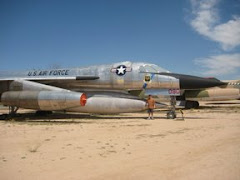The F-86A was far superior to the straight-winged F-51s, F-80s, and F-84s. Those less than suitable fighters were soon put into the ground attack role. The F-86s, more often than not, flew top cover, guarding the Hogs and Stars in the mud below.
The F-86 was rushed into service in Korea when the F-80s and F-84s proved unsuitable in the air-to-air role. Still, it would be nice if there was something that could drop bombs AND fight off the MiGs. So, North American began developing a version of the F-86 that was also suited to the ground attack role.
The F-86F was one of these ground attack F-86s. It was actually used in Korea. It had four wing stores positions and six .50 caliber machine guns.
In May of 1954, there were several F-86Fs at McChord AFB. The men of the 435th Fighter Squadron, part of the 479th Fighter Group, out of George AFB, California, were serving at McChord for a short time. They were there for training no doubt. On the morning of May 28, 1954, 2nd lt. Jack Moore was set to be wingman on a flight of two for a simulated strafing and napalm mission against aggressor forces on a hilltop. Moore was flying F-86F #51-13352, a Block 25 aircraft built at North American Aviation's Columbus, Ohio plant.
This mission was part of a joint Air Force and Army maneuver that was being conducted at the Yakima Firing Range.
The mission called for a two ship flight flown by Second Lieutenant Harry E. Payne and Second Lieutenant Jack Moore. Their call sign was "Hades Black." Payne flew lead. Weather in the target area was set with a ceiling of 10,000 feet with a ten mile visibility. When they got to the target area, Payne could not contact the Forward Air Controller, call sign "Blanket Control," so Moore took the lead and the two began conducting some runs on the enemy position.
After four simulate runs on the target, number two (Payne) called Bingo, or low fuel. Moore, in the lead, said they would make one final pass. The targets were two trucks on top of a ridge. Moore made a pass over the trucks, turning left. He then failed to pull up over the next ridge and struck the ridge approximately 75 feet from the crest. The aircraft exploded upon impact, scattering wreckage for approximately 1200 yards. Lt. Payne reported Moore's loss and returned to base without incident.
The recommendations of the investigating committee were:
1.) Wing, Group, and Squadron leaders should be reviewed for adequacy.
2.) A greater emphasis be placed on the importance of observing minimum altitudes during briefings on missions of this type.
3.) That this accident be brought to the attention of all flying personnel.
Others said of Second Lieutenant Moore: He was well liked. He was unmarried. Considered a "Tiger" and a good pilot but he took some chances. Born in October of 1930, he was only 24 when he died.
The accident is listed as having taken place 28 miles East North East of Yakima, yet the coordinates given show it to be approximately 40 miles to the East, though that is unlikely, since that is farm country.
One thing that is rarely mentioned in all of flying lore, is the losses incurred by training. One suspects that these losses far outweigh those incurred in combat. So ended the career of both Second Lieutenant Jack Moore and his F-86F, #51-13352.
If you have any information on this loss, I would be very interested in hearing from you.
Sources:
Accident report of #51-13352







No comments:
Post a Comment